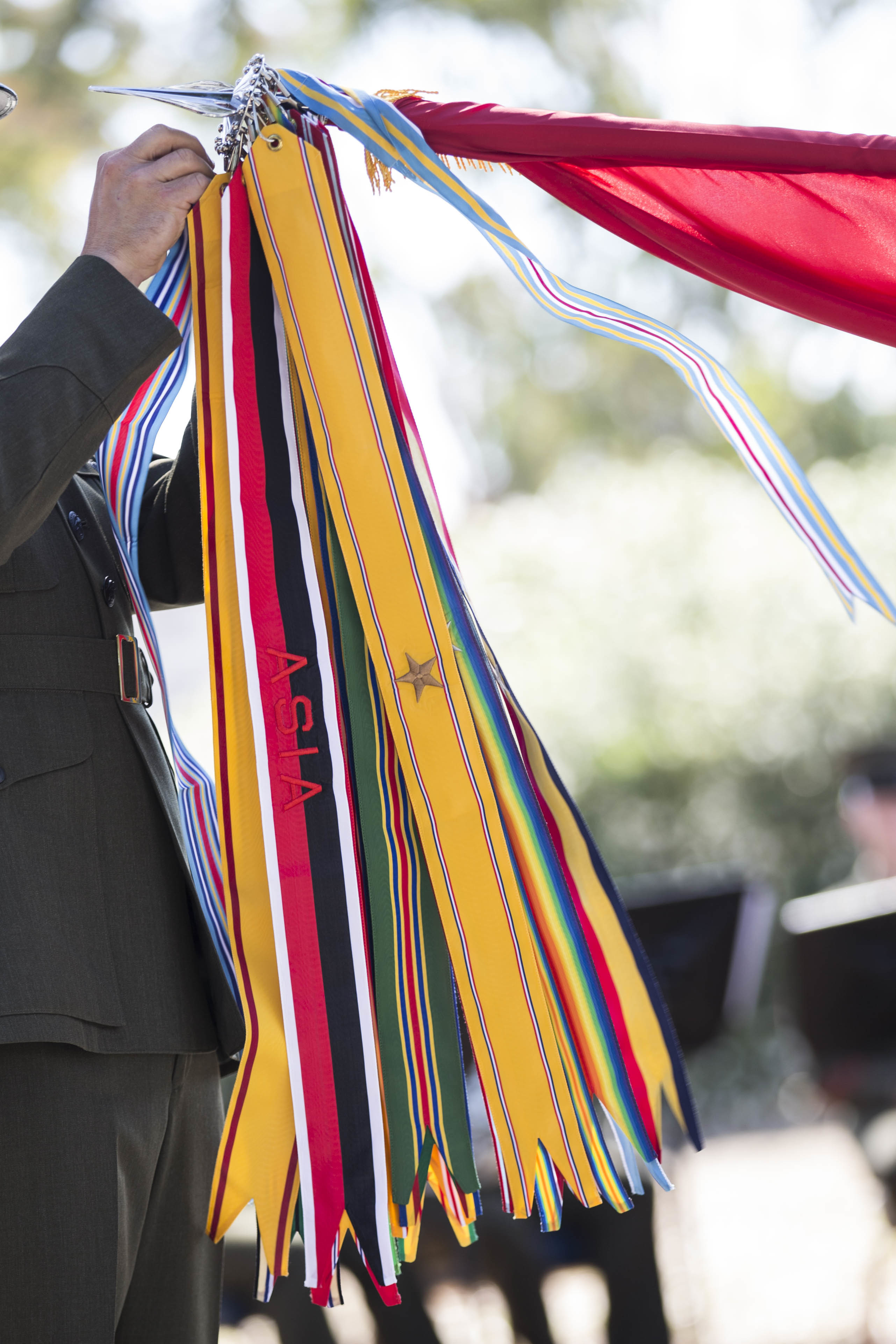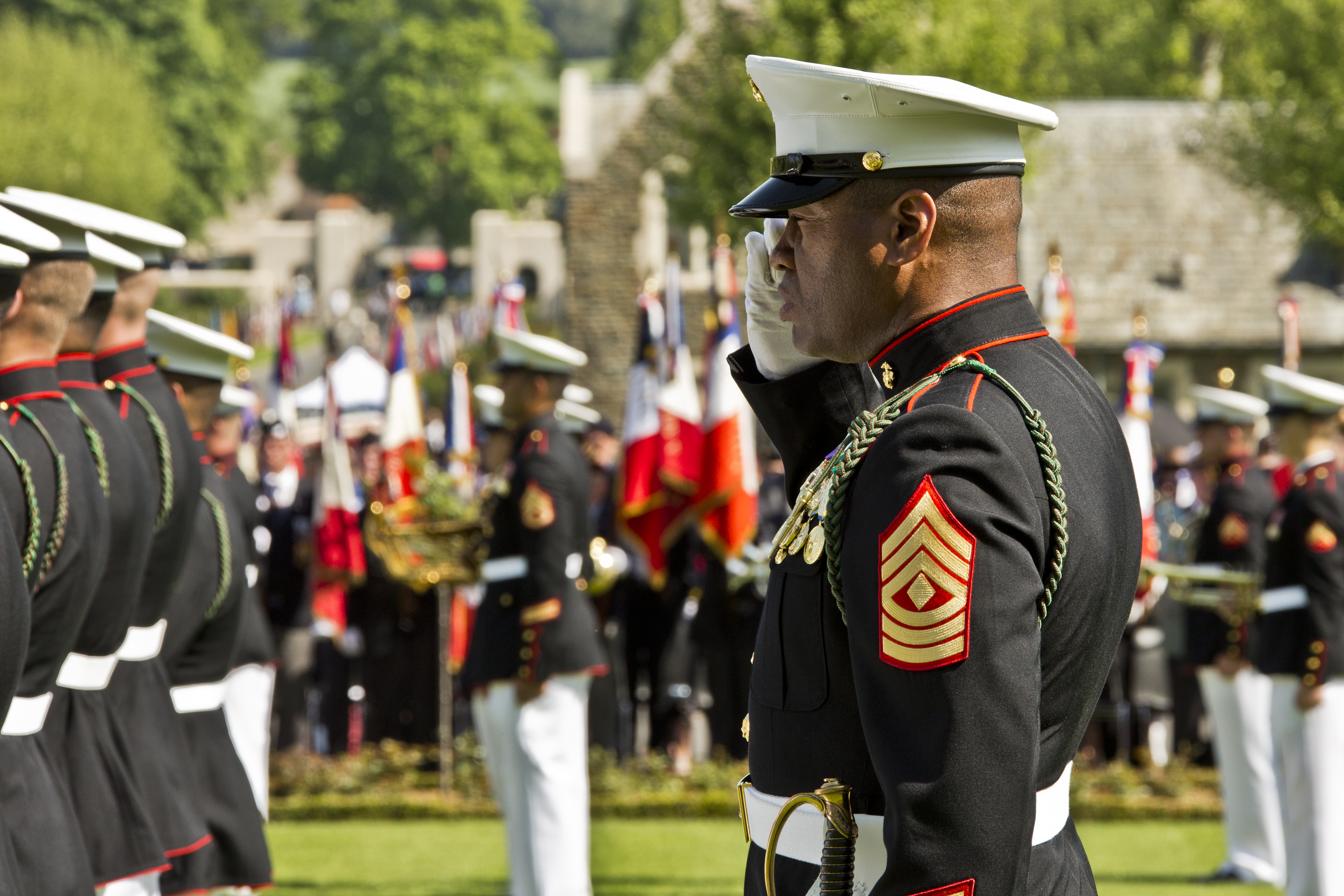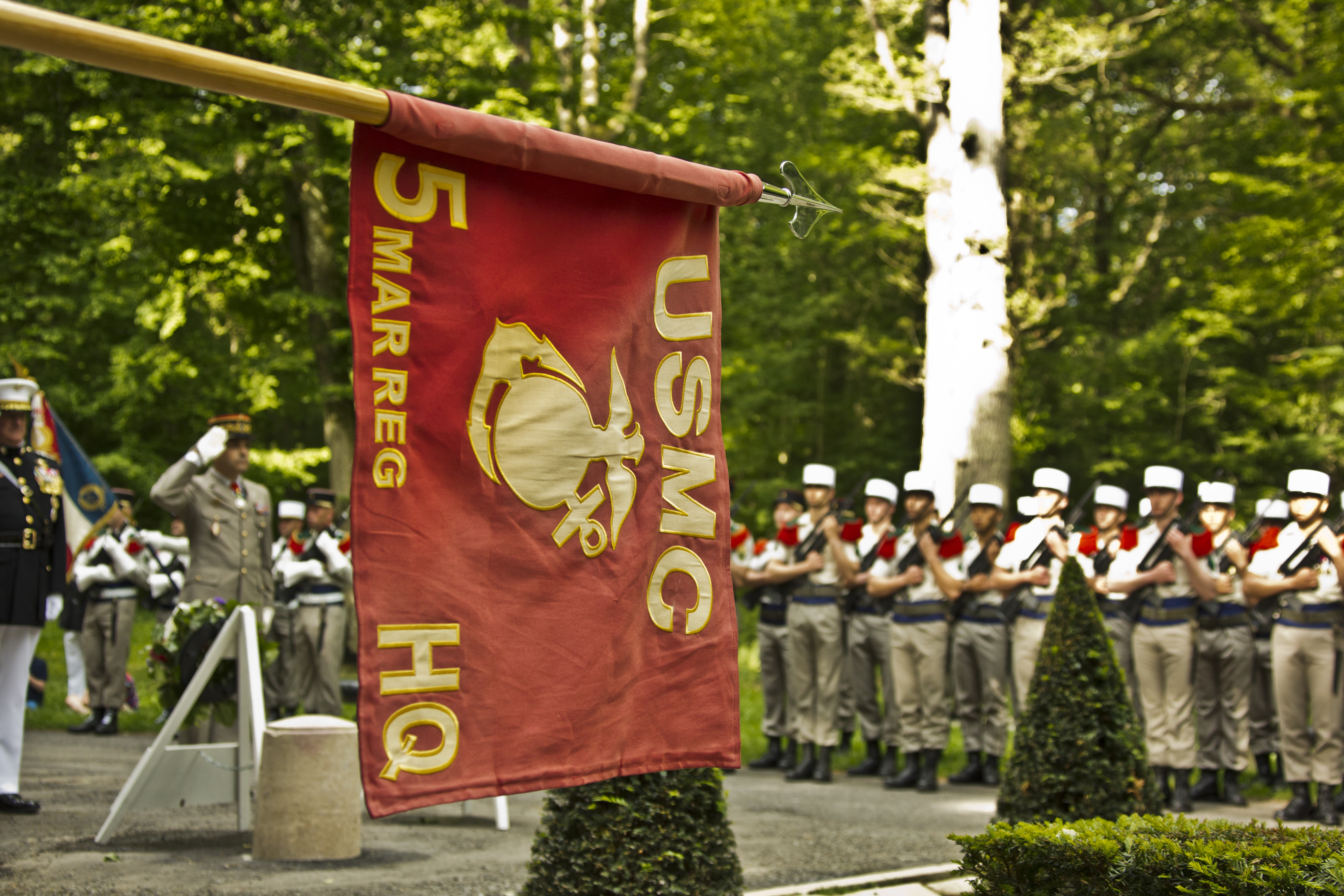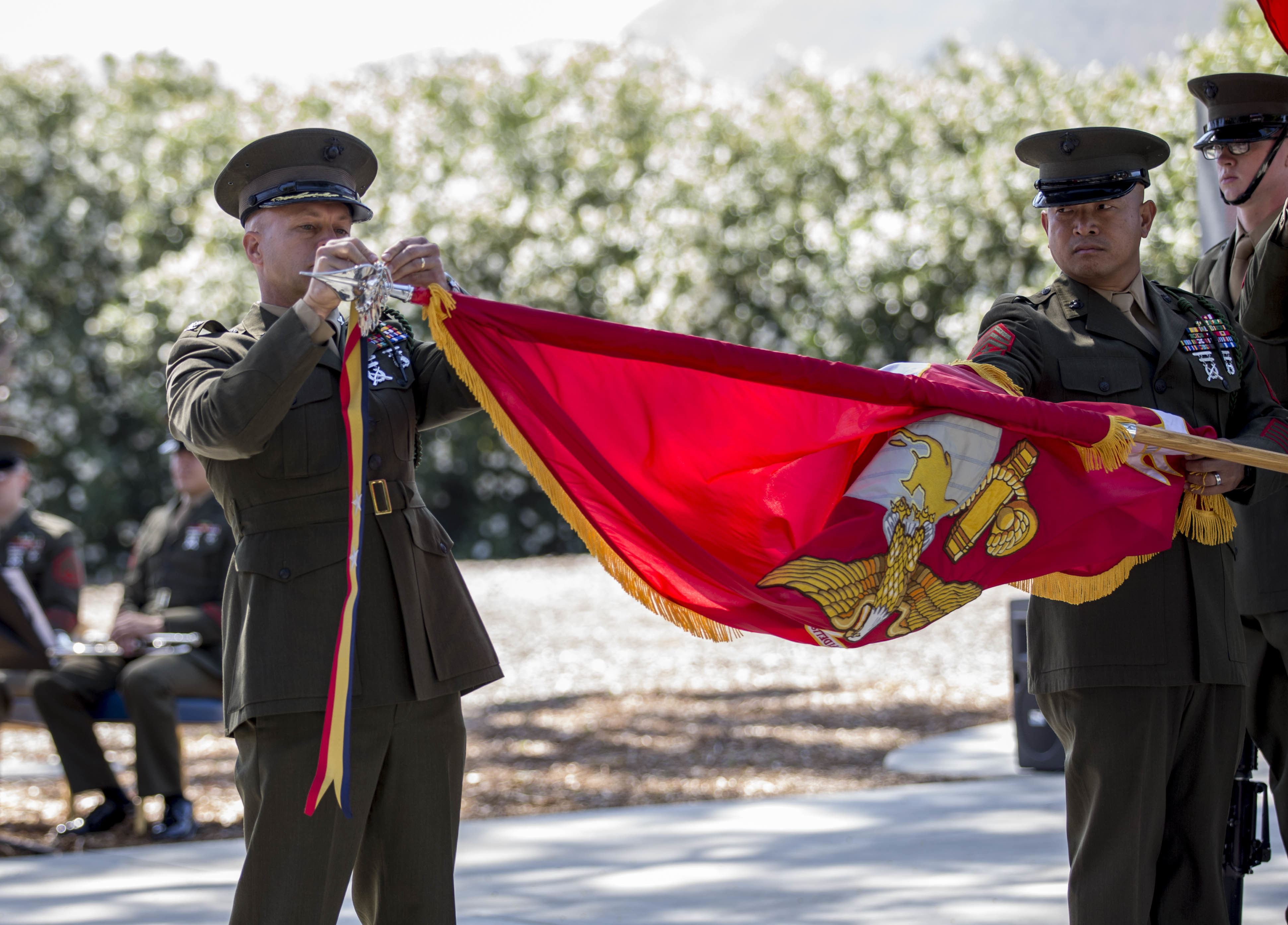
CAMP PENDLETON, Calif. – The Marine Corps’ most decorated regiment marked its 100th anniversary with a re-dedication of its battle colors, and a reminder that today’s Marines and sailors continue their legacy of service and sacrifice from a century of wars, battles and campaigns
During a June 16 centennial ceremony at 5th Marines Memorial Park here, 24 Marines and sailors each handed a battle streamer to Col. George C. Schreffler III, who affixed each ribbon to hooks at the spear atop the flagstaff.
“Those streamers were earned by Marines and sailors – some famous, but most not,” Schreffler told the crowd.
“In war, they moved to the sound of the guns – usually first, when the rest of the nation was unprepared. In peace, they stood the watch, usually far from families at home. In all cases, they answered the nation’s call.”
“Their valor and sacrifice achieved remarkable success, and their example inspired those of us who serve today,” Schreffler said.
The most recent streamer was added onto the regiment’s organizational colors on June 5, 2013, when 5th Marines received the Afghanistan Campaign battle streamer.

Today’s regiment represents the typically busy operational tempo of Marine Corps infantry units: 1st Battalion was at sea training with the 15th Marine Expeditionary Unit for an upcoming deployment with the America Amphibious Ready Group; 2nd Battalion is home after completing a Unit Deployment Program rotation to Japan as the ground combat element for the Okinawa-based 31st MEU; 3rd Battalion is deployed with the 31st MEU after replacing 2/5; and 2nd Battalion, 4th Marines just wrapped up some unit training at Fort Irwin, Calif., the Army’s desert warfare training center in the Mojave desert.
Schreffler, noting every veteran’s story is part of the regiment’s history, told the story of two men – the “unsung, every Marine and every sailor” – who served with “The Fighting Fifth.”
He recalled the experiences of Lt. Col. John W. Thomason Jr. Thomason was a Texan who earned the Navy Cross and Silver Star while serving with 1st Battalion, 5th Marines, during a career that took him to Cuba, China and Haiti. His World War I book about his experiences at Belleau Wood, Fixed Bayonets, remains a mainstay on many Marine Corps reading lists.
And Schreffler told the story of George Washington Ebersole, the athletic trainer at his high school who died at age 84 in 2008 but “still inspires me every day.”
Nicknamed “Speed,” Ebersole served as a Navy hospital corpsman with 1st Marine Division during World War II, landing at Cape Gloucester, Peleliu and Okinawa during the Pacific islands campaigns.
“He could run a workout like the best of our noncommissioned officers,” he said. “He was merciless, and he was caring at the same time.”
Thousands of Marines and sailors endured relentless Imperial Japanese attacks on the islands and on Navy resupply ships that bore critical resupplies. They suffered in the heat and of thirst, yet they continued to fight.
“These guys were tough. They sucked it up and they fought on, in extreme adversity,” the colonel said.
“They prevailed. I wanted to be like that.”

Schreffler joined about 40 regimental Marines who traveled to France for Memorial Day ceremony at Aisne-Marne American Cemetery commemorating the June 6, 1918, start of the Battle of Belleau Wood.
“Being on the ground where your predecessors fought really drives home that message. The charge to those Marines is to talk with their friends back in the United States about what you’ve experienced,” he told USNI News after the ceremony. The trip helped reinforce history lessons and regiment’s heritage that “we will be tested, and we must be ready to make our contribution to the traditions of things endured and things accomplished.”
What makes 5th Marines the most-decorated regiment is a function of time and place. The regiment’s units joined in fighting during both World War I and WWII, as well as during the Korea and Vietnam wars – both of which had heavy focus on 1st Marine Division units – earning battle and campaign streamers along the way in every major conflict.
But 5th Marines shares a unique honor with a counterpart with 2nd Marine Division.
Only two regiments – 5th Marines and Camp Lejeune, N.C.-based 6th Marines – wear the French Fourragere. The green-and-red cord was awarded by France to honor the regiments’ combat heroics and actions in France during World War I. Like the “Fighting” 6th Marines, which in July will also turn 100, 5th Marines formed on June 8, 1917, as the U.S. military prepared to send troops to fight in Europe.

Anyone assigned permanently to a regimental unit wears the fourragere on their left shoulder of their service dress coat. Receiving it is a rite of passage in itself, as newly-assigned Marines and sailors are given the decoration during ceremonies. That cord is a permanent, physical symbol on their uniforms of the regiment’s legacy and “an understanding of what our regiment’s history is all about,” said Sgt. Maj. Chuong Nguyen, 5th Marine Regiment sergeant major.
“We have the privilege of being able to wear it,” Nguyen told USNI News.
“It’s not just something that you can go to the PX and just buy it. It actually was earned with blood, with lives, with wounds that some of our members have to carry with them.”
The Battle of Belleau Wood and subsequent combat at Chateau-Thierry and Soissons that summer in France marked a pivotal time for the Marine Corps as a ground fighting force.
“For the Germans, that was the last stop before they went into Paris,” he said.
Marines and sailors receive their fourrageres when they check into the regiment.
“You’ll have it in your heart for life,” Nguyen said.
“If you move onto your next duty station, the only place where you can wear it is when you’re actually attached to 5th Marines regiment and the battalions under us.”
Regimental Marines say they appreciate the significance of things like battle streamers and fourragere that mark their unit’s legacy and place in history.
“It is very humbling. That’s why we’re the ‘Fighting Fifth,’” said Sgt. Andre Wanzer, with the 5th Marines regimental color guard. As the color sergeant, he carried the U.S. flag for the centennial ceremony, standing next to Lance Cpl. Stephen Boyd, 24, a radio operator from Port Charlotte, Fla., who carried the regimental colors.

Color guard members with 5th Marines’ Headquarters Company have their own spin on wearing the fourragere: They twist it around five times in the back, and then in the front of the button shoulder. “It’s mostly a personal preference,” said Wanzer, 26, of Nokesville, Va.
Lance Cpl. John Goudey, 20, recently got his fourragere. The field radio operator from Alaska recently joined 5th Marines after completing initial communications training at Twentynine Palms Marine Corps Air-Ground Combat Center, Calif.
“There’s a lot of history. There’s big shoes to fill.,” Goudey said.
“I’m looking forward to deployment.”
Lance Cpl. James Powers, 20, Gettysburg, Pa., a generator mechanic, is assigned to the regimental color guard and last month went to France with Schreffler and several dozen Marines from the regiment. They toured and walked through the battlefields at Belleau Wood.
“It was eye opening,” Powers said.
“We got to see actual entrenchments. To see what they had to go through, the sheer magnitude of it, was insane.”
The colonel reminded the Marines “what 2/5 had done and what 2/6 had done. You see the Germans in the tree lines. He said, picture yourself trying to get to them, trying to get to what the Marines before you did, and try to understand how hard it was,” Powers said.
“Marines were crawling in fields that the brush was this high and they couldn’t see. They were going blind towards people who were shooting automatic weapons at them. The Germans were masters at automatic weapons and machine guns. They would cut Marines down like it was nothing.”





